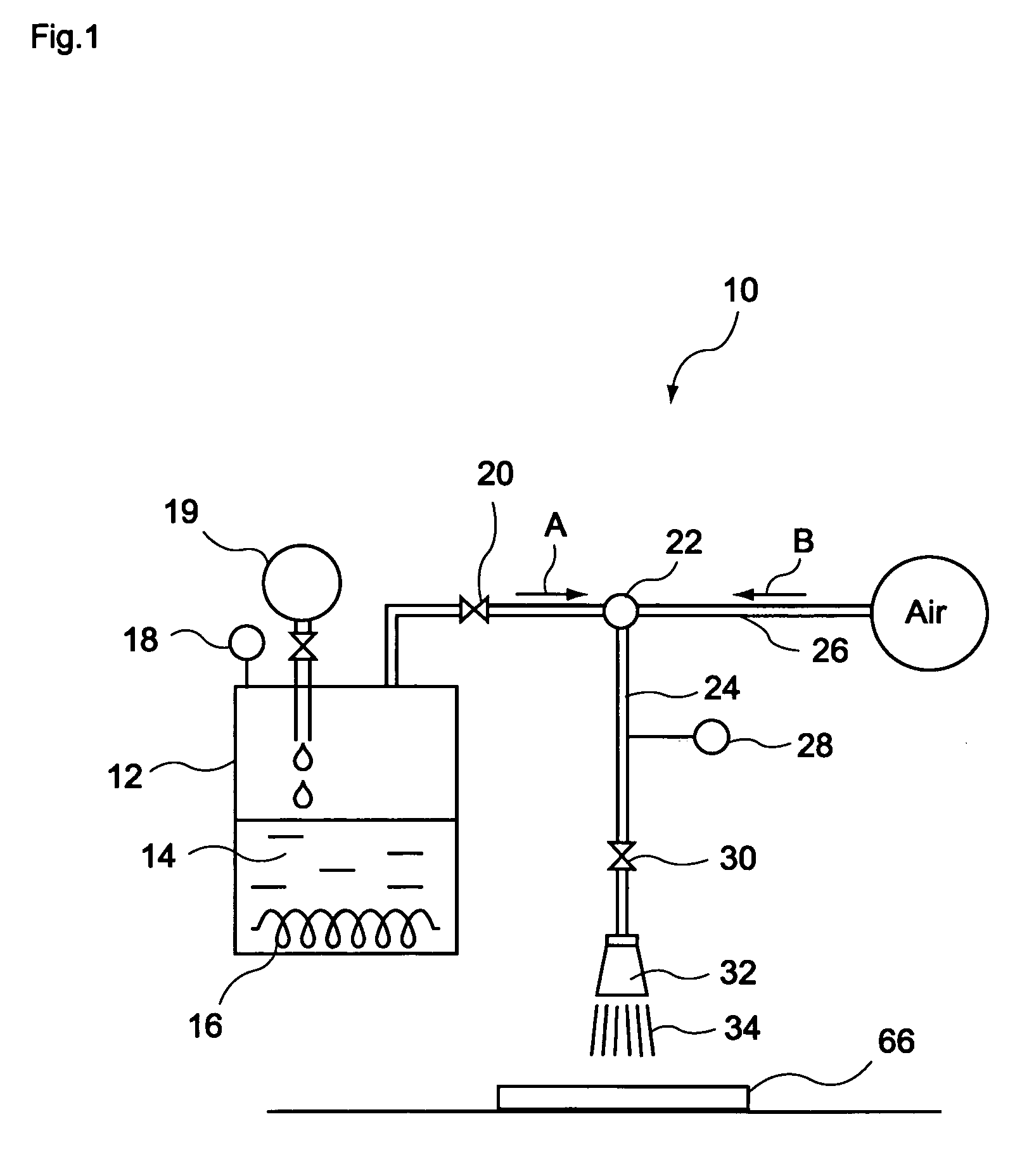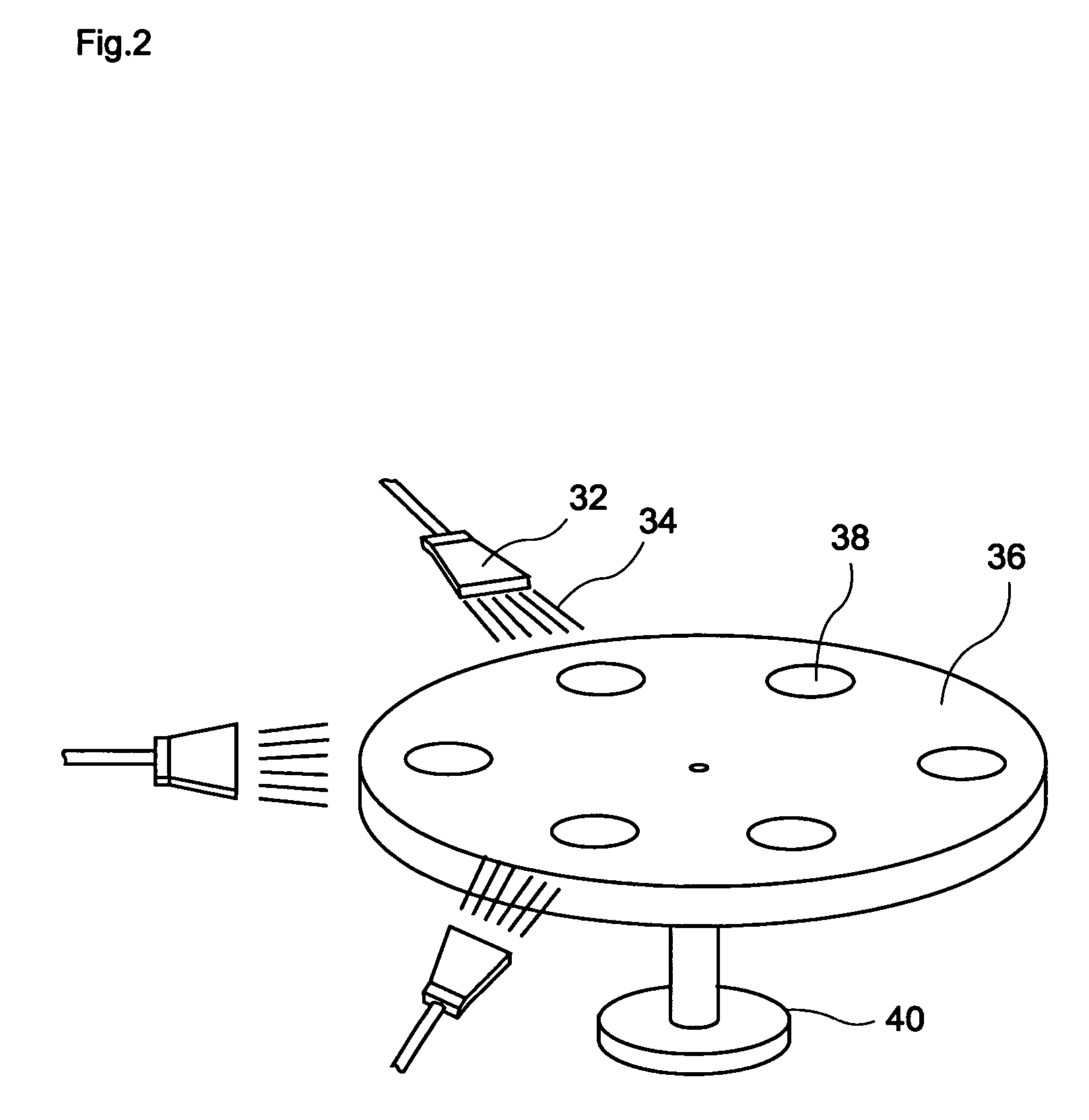Method for surface preparation of solid substances and surface-prepared solid substances
a technology of solid materials and surface preparation, which is applied in the direction of plasma technology, coatings, transportation and packaging, etc., can solve the problems of poor adhesion strength and surface smoothness in comparison with other metals, and the difficulty of being attached to other members or being subjected to surface treatments such as adhesion printing and uv coating, etc., and achieve excellent adhesion strength.
- Summary
- Abstract
- Description
- Claims
- Application Information
AI Technical Summary
Benefits of technology
Problems solved by technology
Method used
Image
Examples
first embodiment
[0025] The first embodiment is a method for modifying a surface of a solid material wherein the surface of the solid material is subjected to silicatizing flame treatment such that the surface of the solid material is wholly or partially blown with a flame from a fuel gas that comprises a silicon-containing compound having a flash point of 0 to 100° C. and a boiling point of 105 to 250° C.
1. Solid Material
[0026] According to the first embodiment, typically, the solid material used may be silicone rubber or fluorine-contained rubber but details thereof will be explained in the second embodiment.
2. Fuel Gas
(1) Silicon-Containing Compound
(i) Flash Point
[0027] It is characteristic for the flash point of the silicon-containing compound (in closed or opened system) to be in a range between 0 and 100° C.
[0028] The reason for this is that if the flash point of the silicon-containing compound is below 0° C., the handling may be difficult in storage and the combustion rate may be d...
second embodiment
[0079] The second embodiment is a surface-modified solid material having a wetting index of 40 to 80 dyn / cm (measuring temperature 25° C.) attained by subjecting the surface of the solid material wholly or partially to a blow treatment with a flame of a fuel gas that comprises a silicon-containing compound having a flash point of 0 to 100° C. and a boiling point of 105 to 250° C.
1. Solid Material
(1) Rubber
[0080] Furthermore, for constructing the surface-modified solid material, the solid material may be at least one of rubber types selected from the group consisting of: silicone rubber, fluorine-contained rubber, natural rubber, neoprene rubber, chloroprene rubber, urethane rubber, acryl rubber, olefin rubber, styrene-butadiene rubber, acrylonitrile-butadiene rubber, ethylene-propylene rubber, ethylene-propylenediene rubber, butadiene rubber, butyl rubber, styrene type thermoplastic elastomer, and urethane type thermoplastic elastomer.
[0081] Among these rubber types, an excell...
third embodiment
[0114] The third embodiment is an apparatus 10 for modifying a surface of a solid material, as shown in FIG. 1, containing a storage tank 12 for storing a silicon-containing compound 14 having a flash point of 0 to 100° C. and a boiling point of 105 to 250° C., a transfer part 24 for transferring the fuel gas and an outlet part 32 for letting out the fuel gas flame 34 for blow treatment.
1. Storage Tank
[0115] As shown in FIG. 1, preferably, the storage tank may comprise a first storage tank 12 having a heating device 16, for storing the silicon-containing compound 14, and a second storage tank (not shown) for storing an inflammable gas such as compressed air and the like. In this example, the heating device 16 is mounted on the bottom part of the first storage tank 12. The heating device 16 may comprise a heater and a heat transfer line, or may comprise a heating board or the like that is connected to a heat exchanger, for evaporating the silicon-containing compound 14 in a liquid...
PUM
| Property | Measurement | Unit |
|---|---|---|
| Temperature | aaaaa | aaaaa |
| Temperature | aaaaa | aaaaa |
| Temperature | aaaaa | aaaaa |
Abstract
Description
Claims
Application Information
 Login to View More
Login to View More - R&D
- Intellectual Property
- Life Sciences
- Materials
- Tech Scout
- Unparalleled Data Quality
- Higher Quality Content
- 60% Fewer Hallucinations
Browse by: Latest US Patents, China's latest patents, Technical Efficacy Thesaurus, Application Domain, Technology Topic, Popular Technical Reports.
© 2025 PatSnap. All rights reserved.Legal|Privacy policy|Modern Slavery Act Transparency Statement|Sitemap|About US| Contact US: help@patsnap.com



